
Fictional circus poster from "X2"
I rewatched "X2/X-Men United" recently and an interesting detail struck my attention. I'm still not quite sure what to make of it. The movie begins with an assassination attempt on the U.S. President by a brainwashed Nightcrawler. As an X-Men fan I was not totally enchanted by all the choices they made for the character, though Alan Cumming was excellently cast (speaking of interesting effects of casting, how great that Kitty Pryde of "X-Men 3" is played by Ellen Page, who is also "Juno"). There is a very interesting allusion director Bryan Singer made just as the Nightcrawler character was introduced.

Prior to his attack on the Secret Service and the President, a disguised Nightcrawler was part of a White House tour group. IMDb's "X2" trivia listing notes that in this scene, portraits of assassinated Presidents Lincoln, McKinley and Kennedy are prominently displayed (and also Washington, of interest maybe to Washington/Weishaupt theorists). This makes easy enough sense for the scene that follows, however, the interesting thing was a decision to feature the famous 1970 Aaron Shikler "Oil Portrait of John F. Kennedy" with Nightcrawler beside it displaying a highly similar posture as Kennedy in the portrait. This was undoubtedly done purposefully.
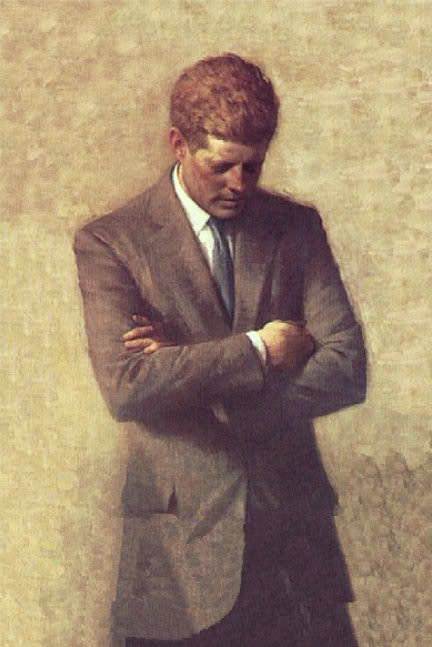
I find this brief moment one that resonates on more then one level. We quickly learn that Nightcrawler was under the mind control of the mutant hating army Colonel William Stryker (played by Brian Cox). Nightcrawler is a mutant Manchurian Candidate. Thus this visual connotation between the character and a posthumous portrait of JFK seems a very economic manner in which to make a subtle statement about Lee Harvey Oswald. Mind control is one of the major themes of "X2" and a point I'll be returning to in the course of this article.
But I don't think that's quite the sum of what is being said with the Nightcrawler/JFK shot. It is not Lee Harvey Oswald whom Nightcrawler is being paralleled to, it in Kennedy himself. This certainly does not make a lot of immediate sense, and the typical reaction, if a viewer were to note this subtle symbol-play at all, would be to make the leap to Oswald. If I was forced to make a bet I would say that was the film maker's intent. However, synchronistically it says something else about the Nightcrawler character and the X-Men franchise in general.
My intent with writing on the X-Men comics was to start at the beginning and work my way through to my terminus point as a regular reader in the late '80s. I did not intend to 'port about randomly, but there's something here I can't ignore or store away for the moment when my organization catches up to my intentions. So let's talk about Nightcrawler.
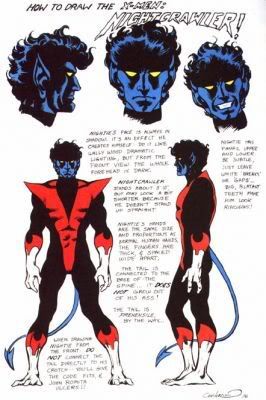
Art by Dave Cockrum
The name, Nightcrawler, has the connotation of one who moves through the darkness, thus an adept of the Mysteries/Occult. The character's real name is Kurt Wagner, which I've always assumed was a reference to German composer Richard Wagner. Note the yonic, or grail-like shapes of Nightcrawler's costume. This is in fact a trait shared by most of the costumes of the second generation of X-Men. The sole exception was the hold over from the original team, the linear Cyclops.
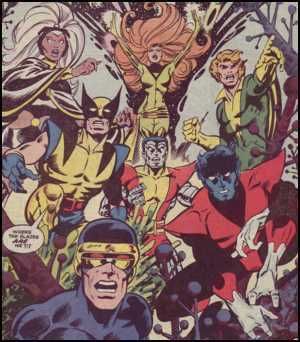
Art by Dave Cockrum
As the story goes, Nightcrawler was originally designed by illustrator Dave Cockrum as a character for DC's Legion of Super-Heroes (due primarily to Cockrum's important tenure on both titles there are several links between the Legion and the X-Men). According to Wikipedia the design was rejected, oddly, for being "too alien". When Cockrum moved from DC to Marvel the character was redeveloped by Cockrum and writer Len Wein as one of the second generation X-Men. His first published appearance in May 1975's "Giant-Size X-Men" #1.
A mutant from Germany, the infant Kurt Wagner was described as being found abandoned in the Bavarian Alps by a gypsy/sorceress named Margali Szardos. His supposed father Eric Wagner was found nearby dead from a heart attack. Margali made a living as a fortune-teller for a small circus, and she brought the infant to them. The circus folk accepted his freakish appearance and he was raised as one of their own. Margali acted as his foster mother and his best friends were her son Stefan and her daughter Jimaine. Kurt trained and worked as an acrobat and aerialist at the circus. As I've said before, the circus always makes a nice reference to the zodiac.
As a young adult Kurt quit the circus when it was bought by a Texas millionaire who planned to move the best acts to the United States, and intended Kurt be moved to the freak show. Kurt then made his way to the village of Winzeldorf where his foster brother Stefan was living. Kurt found that Stefan had gone mad and murdered several children. During a violent confrontation Stefan died when his neck was accidentally broken. Based on his demonic appearance, the villagers assumed Kurt was the one who murdered the children, and he was attacked by an angry, torch-wielding mob. He was rescued by Professor X who then recruited Kurt as one of the New X-Men.
Later, as depicted in 1980's "X-Men King-Size Annual" #4, Margali cast Kurt into a facsimile of Dante's Inferno as punishment for Stefan's death, for which she mistakenly held Kurt responsible. With the help of Doctor Strange the X-Men rescued Nightcrawler and the truth was revealed to Margali by Strange's All-Seeing Eye of Agamotto. At this time Kurt also learned that his foster-sister Jimaine, a sorceress like her mother, had been posing as his girlfriend, Amanda Sefton. It is one of the X-Men's stranger adventures, which is really saying something. In a story titled "Nightcrawler's Inferno", Amanda/Jimaine is then a subtle Beatrice. There is a further, more complicated Dante connection in this equation as well.
Eventually Nightcrawler learned that his birth-mother is the mutant, terrorist leader of the second Brotherhood of Evil Mutants, the blue Mystique. At a later point, in an unpopular storyline, Nightcrawler's true birth father was revealed as the demonically named Azazel, an evil warlord from a race of demon/mutants. Originally long-time X-Men writer Chris Claremont intended a very different, and far more intriguing parentage for Nightcrawler. Claremont's concept was for Nightcrawler to have been the son of Mystique and her long-time female companion, the precognitive Destiny. The shape-shifting Mystique would have taken male form and impregnated Destiny, making Mystique Kurt's female father. This concept was nixed as too controversial. That's a shame, but I rather like this detail as part of the esoteric origin of Nightcrawler, the offspring of Mystery and Fate. Between Mystique, Destiny and the green-skinned, ram-horned Margali, Nightcrawler has three mothers, all of whom resonate aspects of the Goddess. Tripartite depictions of the Goddess are to be expected.
This combines with Nightcrawler's powers to make a character of high intrigue. Nightcrawler is of course a teleporter, a living stargate. He shares Spider-Man's ability to walk on walls and his super-human agility. The two male, goddess resonating figures hold much in common. Another ability of Nightcrawler's, one erratically presented, is his shadowy nature. Even in normal lighting Nightcrawler is typically depicted as being partially in shadows. At one point he learns (from leprechauns no less) that he not only blends into the shadows, he becomes completely invisible in darkness.
But what does all of this have to do with JFK? One factor is that Nightcrawler is depicted as a Catholic, and of course Kennedy was the first and so far only Catholic U.S. President. In another relatively recent storyline Nightcrawler nearly became a Catholic priest and in a convoluted storyline was almost made the Pope of the Marvel Universe. In "X2", after Nightcrawler fled the White House, he hid out in an abandoned church in Boston. There's no real reason for the use of Boston in this movie and I wonder if it was utilized as a further synchronization to Kennedy.
The other shared detail of Nightcrawler and Kennedy is as targets of assassination. Nightcrawler is one of the many Marvel characters who was killed prior to the events presented in the monumental X-Men storyline "Days Of Future Past". Details of his death in this alternate time line were later revealed when Rachel Summers escaped her own dystopian reality and joined the cast of the X-Men. We learn the dominance of the Sentinels was preceded by an assault on Xavier's School For Gifted Youngsters. As Nightcrawler and his (in that reality) wife Amanda Sefton walked Illyana Rasputin, the younger sister of Colossus, to meet her school bus, all three were gunned down by unseen snipers. Another assassination victim in this attack was Professor X, who is frequently compared to the Reverend Martin Luther King, Jr.
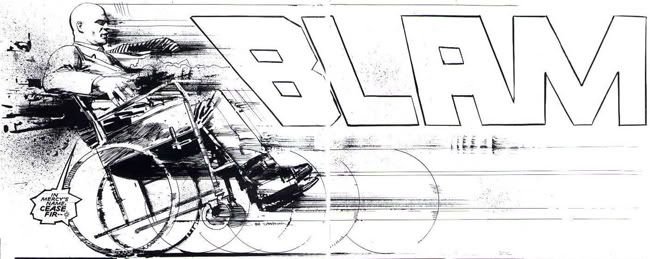
Art by Bill Sienkiewicz
"X2" includes a prominent, though far less dramatic or devastating, military assault on Xavier's School. It is safe to say that Singer was aware of the source material of this plot point. The primary comic book source for the story of "X2/X-Men United", however, is not "Days of Future Past", but rather the exceptional 1982 Marvel Graphic Novel #5, "God Loves, Man Kills".
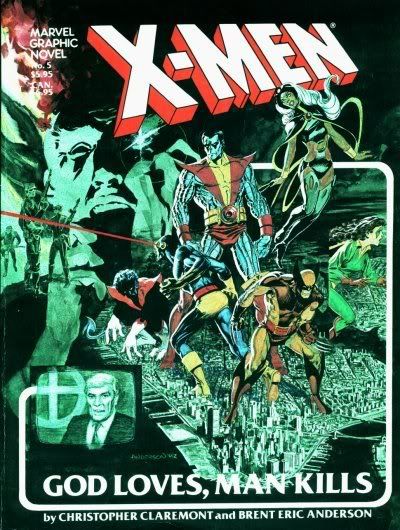
Art by Brent Anderson
Like "X2", "God Loves, Man Kills" featured the X-Men teaming with Magneto to stop a plot by anti-mutant activist William Stryker. One of the major differences, however, is that Stryker, rather then being an Army colonel, was a fundamentalist Christian televangelist whose ministry was spreading a message that mutants were the product of Satan. As in "X2", Professor X was abducted and brainwashed by Stryker into a telepathic weapon of mass destruction, hooked up to a machine that enhanced his abilities to the point where he could murder every mutant on the planet simultaneously. In the graphic novel the brainwashing involved a series of induced hallucinations, including a nightmare where Xavier was crucified by the X-Men. For some reason this was depicted as taking place atop one of the towers of the World Trade Center.
And these are not the only times when the Nightcrawler character has been presented in assassination themed storylines. I mentioned the similarities between Nightcrawler and Spider-Man and indeed the two have been depicted on cordial terms, for the most part, since early in Nightcrawler's existence. Of course when they first met they mistook one another as enemies and fought for awhile, but that's to be expected of super heroes. They became friends afterwards. The two first met in October 1976's "The Amazing Spider-Man" #161, the first part of a two-issue story, written by Nightcrawler co-creator Len Wein and illustrated by Ross Andru.
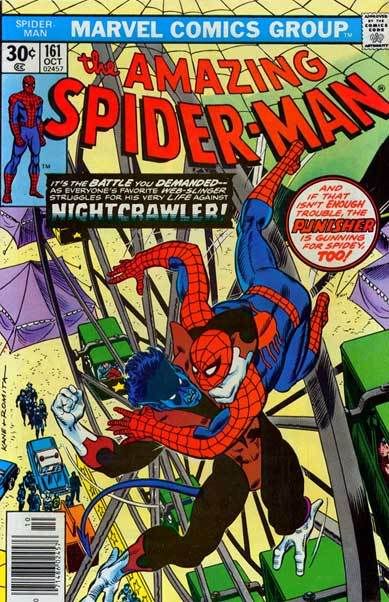
Art by Gil Kane and John Romita
A string of sniper shootings leads to Spider-Man and Nightcrawler mistaking one another for the killer. The shooter is actually purposefully impersonating the Templar resonating vigilante Punisher, and is eventually revealed to be a plot by the Punisher's archenemy, the Dick Tracy-esque Jigsaw (Jigsaw Killer, did you see "Saw"?). I am highly intrigued lately by the connotations of team-up comics, particularly involving Spider-Man and the X-Men, and it's a topic I'll be returning to, I believe in my next post.
If all of that's not confusing enough here's another rather convoluted connection between Nightcrawler and Dante Alighieri and the "Inferno" portion of "The Divine Comedy". Bear with me. Back in the Golden Age of comics when Marvel was Timely, one of their first characters was the Tarzan-clone jungle lord Ka-Zar (as such a definite Dionysus resonator). Ka-Zar actually first appeared as a text character in a pulp magazine in 1936. In the Silver Age the name was reused by Lee and Kirby for a character who debuted in "X-Men" #10, March of 1965. This Ka-Zar was still a jungle lord, but the world he occupied was the "lost world" The Savage Land hidden in Antarctica, populated by dinosaurs and other prehistoric creatures. Ka-Zar's constant companion is the saber-tooth tiger Zabu and he later marries the leopard-skin clad Shanna the She-Devil a jungle heroine in her own right, both of whom reemphasize Ka-Zar's Dionysian nature.
Ka-Zar subsequently appeared several times in the pages of the X-Men and other Marvel titles and starred in several short-lived series of his own. In "Ka-Zar the Savage" #11, February 1982, the demonic sorcerer Belasco was introduced. Belasco was created by writer Bruce Jones and illustrator Brent Anderson, the artist of "God Loves, Man Kills".
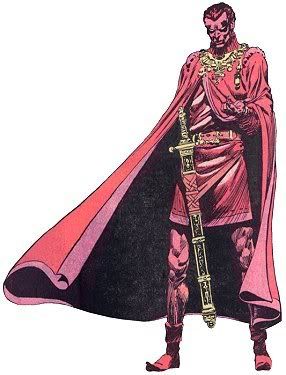
Art by Brent Anderson
As the story goes, the Savage Land was created millions of years in the past by an alien race called the Beyonders (entities separate from the Cosmic Cube born/Secret Wars causing Beyonder) as a kind of zoo. The Savage Land was discovered during the days of ancient Atlantis, and they built a kind of amusement park there, one with a strong resemblance to Hell. In the 13th century Belasco, a Florentine alchemist, made a pact with a race of Lovecraftian "Elder Gods" (a nod no doubt to the Antarctica based "At The Mountains of Madness"). They made him immortal and a powerful sorcerer. In return the now demonic Belasco was to sire a race of Earth-born demons.
He kidnapped Beatrice, the true love of Dante Alighieri, and fled with her to Antarctica, raping and impregnating her on the way. He was pursued by Dante. The chase led them to the Atlantean amusement park in the Savage Land. Dante arrived but was too late to save Beatrice who died in childbirth. Dante and Belasco fought and during their combat a pipe containing some kind of liquid coolant was burst and Belasco was frozen solid, and subsequently buried in an earthquake. Dante returned to Florence and loosely recounted the tragic adventure as part of his epic poem (in which Lucifer is depicted frozen in the bottom Circle of Hell).
Hundreds of years later Ka-Zar and his companions discovered the amusement park while exploring the Savage Land, and found the immortal Belasco had revived. Belasco determined that Shanna was the reincarnation of Beatrice and decided to make her his new bride. Ka-Zar, of course, managed to save Shanna. For his failure, Belasco was punished by the Elder Gods, cast into the timeless dimension called the Otherplace or Limbo. Belasco next appeared in the pages of the X-Men when he kidnapped the aforementioned Illyana Rasputin, seemingly because her mutant ability allowed her to directly enter and exit Limbo. The X-Men pursued through circular portals between worlds.
Apparently X-Men from more then one reality did this and one group became lost in Limbo for many years, during which time Wolverine and Colossus were killed. Nightcrawler was eventually corrupted by Belasco and became the sorcerer's lackey. The X-Men from the "regular" continuity managed to escape however (with the help of the alternate Storm who had become a powerful sorceress in her own right), but lost hold of Illyana just as they were exiting Limbo. They managed to grab hold of her again but when they did they found that she had aged several years. In that time she had been trained as an apprentice of Belasco, eventually overthrowing him and becoming the new ruler of Limbo.
This story was further related to Nightcrawler years later in the pages of "Excalibur", involving his foster mother Margali and his girlfriend Amanda/Jimaine in overtly complicated ways (Winding Ways). Then in Alex Ross and Jim Kreuger's alternate Marvel future story line Earth X, which is not considered canonical, Belsaco was revealed to have originally been a time-displaced Nightcrawler who had lost his memory and morality, and gained a similar but different hued form, due to a deal he made with Mephisto (the same devilish entity with whom Marvel had Spider-Man recently make a deal). So again we have the pure-hearted Nightcrawler turned into a tool for an evil plot. In this case a Mephistian Candidate.
No comments:
Post a Comment